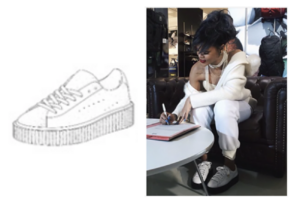The European Court of Justice affirmed an earlier decision of the European Intellectual Property Office (EUIPO) in a case where Puma was attempting to gain a European Union (EU) Community Design on its “Puma Creeper Shoe.” On March 6, 2024, the EU Court struck down the validity of Puma’s registered EU design, based on a number of social media posts by Rihanna.
EU Design Patent Protection
Under EU design patent law, novelty and individual character are two of the requirements to obtain EU Design protection. In order to show novelty, the appearance of the design, or the portion of the design for which the applicant seeks protection, must be new. In other words, novelty exists if there is no identical design or if there is no similar design with only minor changes to its ornamental details. Individual character exists if the new product design creates a different overall impression than an existing product. Similar to US Design practice, the lines, contours, surface, and elevation of portions of an object, such as the Puma Creeper Shoe, must be new (i.e., original, unique, or novel). Thus, a shoe, or a shoe portion, cannot have been previously invented.
Even if an EU Design is granted, some provisions allow for a design patent to be invalidated. One example is if the design seeking protection is made available to the public prior to twelve months preceding the design patent’s filing date. (Council Regulation 6/2002, on Community Designs, 2002.) Whether or not a designer or a third party discloses the design is inconsequential as it pertains to public disclosure. Thus, a public disclosure can be novelty destroying and prevent an otherwise valid EU Design application from being granted.
US Patent Law provides a similar remedy. The “public-use” provisions in 35 USC establishes that “a person shall be entitled to a patent unless the claimed invention was patented, described in a printed publication, or in public use, on sale, or otherwise available to the public before the effective filing date of the claimed invention.” (35 U.S.C. § 102(a)(1).) A disclosure made one year or less before the effective filing date of a claimed invention shall not be prior art to the claimed invention if the inventor or joint inventor made the disclosure… (35 USC § 102(b)(1)(A).) Thus, the timing of a disclosure in advance of the design patent filing date is critical in determining the validity of the design patent.
Parties and the Case
The Puma dispute dates back to 2019, when a Dutch footwear wholesaler, Handelsmaatschappij J. van Hilst (HJVH), applied for a declaration of invalidity against Puma’s registered Puma Creeper Shoe design. In support of the wholesaler’s application, HJVH provided a series of photographs that Rihanna had shared via her Instagram account in 2014, in which she wore a pair of Puma trainers. These posted images were also reproduced in several news sources in 2014. As Puma filed an EU design application to protect the Puma Creeper Shoe design in July 2016, HJVH argued that the sharing of these photos occurred beyond the one-year grace period afforded to Puma. HJVH further argued that the Puma Creeper Shoe lacked the required novelty to qualify for an EU design patent. Following its review of the matter, the EUIPO found that Puma’s design was invalid because it lacked individual character, due to being disclosed more than one year before the filing date.
Puma appealed the EUIPO’s decision to the European Court of Justice, arguing that at least the evidence before the EUIPO was insufficient to demonstrate prior disclosure of Puma’s design in accordance with the Regulation. Puma alleged that fans did not take an interest in the shoes when they were featured in Rihanna’s 2014 Instagram post and, instead, focused on Rihanna herself. The Court was not persuaded by this argument. The Court provided several reasons, but one included that “Rihanna was a world-famous pop star,” with both her fans and others in the fashion sector being interested in the shoes she posted. Therefore, the Court found that it was reasonable for people to closely study the photos of the shoes posted to see the exact style she was wearing. Thus, the Instagram photos were sufficient evidence showing the Puma Creeper Shoe design was publicly disclosed more than one year prior to the filing of an application for an EU Design.

Community Design No. 003320555-0002
Source: https://www.politico.eu/article/rihanna-instagram-post-puma-hopeless-place-european-union/
Practice Tip
The courts relying on the use of social media by Puma, Rihanna, and news sources show the level of care that must be taken at every stage of the design process of a new product, including the disclosure and patent registration process. Companies advertise on social media outlets and form partnerships with influencers or ambassadors; however, if the companies have not filed for design patent protection prior to such advertisements and/or partnerships publicly using their products, the companies may lose their rights to obtain a design patent. A company or individual should speak with a patent attorney during its design process and, ideally, prior to any public disclosure of its product, to determine whether a design patent can protect its product.
What’s more, unlike US Design patent law, the EU Design is not examined before being registered. Thus, an assignee holding a EU design may not have a valid EU design patent, and that EU design patent, when challenged, can be invalidated.
If you have any questions about US and global design practice, trade dress, online enforcement, and brand protection, please do not hesitate to contact Ryan Smith at RCSmith@dickinson-wright.com or Andrea Arndt at AArndt@dickinson-wright.com.
Related Services:
About the Authors:
 Ryan C. Smith focuses his practice on intellectual property, specifically as it relates to chemical and life science technologies. From individual innovators to startups and fortune 500 companies, he represents clients in the consumer products, biomedical, food science, agriculture, chemical, and medical device industries. He can be reached at 954-991-5440 or RCSmith@dickinsonwright.com, and his bio can be accessed here.
Ryan C. Smith focuses his practice on intellectual property, specifically as it relates to chemical and life science technologies. From individual innovators to startups and fortune 500 companies, he represents clients in the consumer products, biomedical, food science, agriculture, chemical, and medical device industries. He can be reached at 954-991-5440 or RCSmith@dickinsonwright.com, and his bio can be accessed here.
 Andrea L. Arndt is a Member in Dickinson Wright’s Austin office, where she focuses her practice on patent prosecution. She can be reached at 248-433-7677 or AArndt@dickinsonwright.com, and her biography can be accessed here.
Andrea L. Arndt is a Member in Dickinson Wright’s Austin office, where she focuses her practice on patent prosecution. She can be reached at 248-433-7677 or AArndt@dickinsonwright.com, and her biography can be accessed here.
